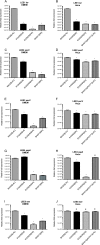Atypical enteropathogenic Escherichia coli that contains functional locus of enterocyte effacement genes can be attaching-and-effacing negative in cultured epithelial cells
- PMID: 21343354
- PMCID: PMC3088124
- DOI: 10.1128/IAI.00693-10
Atypical enteropathogenic Escherichia coli that contains functional locus of enterocyte effacement genes can be attaching-and-effacing negative in cultured epithelial cells
Abstract
Enteropathogenic Escherichia coli (EPEC) induces a characteristic histopathology on enterocytes known as the attaching-and-effacing (A/E) lesion, which is triggered by proteins encoded by the locus of enterocyte effacement (LEE). EPEC is currently classified as typical EPEC (tEPEC) and atypical EPEC (aEPEC), based on the presence or absence of the EPEC adherence factor plasmid, respectively. Here we analyzed the LEE regions of three aEPEC strains displaying the localized adherence-like (LAL), aggregative adherence (AA), and diffuse adherence (DA) patterns on HEp-2 cells as well as one nonadherent (NA) strain. The adherence characteristics and the ability to induce A/E lesions were investigated with HeLa, Caco-2, T84, and HT29 cells. The adherence patterns and fluorescent actin staining (FAS) assay results were reproducible with all cell lines. The LEE region was structurally intact and functional in all strains regardless of their inability to cause A/E lesions. An EspF(U)-expressing plasmid (pKC471) was introduced into all strains, demonstrating no influence of this protein on either the adherence patterns or the capacity to cause A/E of the adherent strains. However, the NA strain harboring pKC471 expressed the LAL pattern and was able to induce A/E lesions on HeLa cells. Our data indicate that FAS-negative aEPEC strains are potentially able to induce A/E in vivo, emphasizing the concern about this test for the determination of aEPEC virulence. Also, the presence of EspF(U) was sufficient to provide an adherent phenotype for a nonadherent aEPEC strain via the direct or indirect activation of the LEE4 and LEE5 operons.
Figures



Similar articles
-
Expression of the locus of enterocyte effacement genes during the invasion process of the atypical enteropathogenic Escherichia coli 1711-4 strain of serotype O51:H40.Microbiol Spectr. 2024 Oct 3;12(10):e0030424. doi: 10.1128/spectrum.00304-24. Epub 2024 Aug 27. Microbiol Spectr. 2024. PMID: 39189752 Free PMC article.
-
Late establishment of the attaching and effacing lesion caused by atypical enteropathogenic Escherichia coli depends on protein expression regulated by Per.Infect Immun. 2015 Jan;83(1):379-88. doi: 10.1128/IAI.02563-14. Epub 2014 Nov 10. Infect Immun. 2015. PMID: 25385791 Free PMC article.
-
Genetic relatedness and virulence properties of enteropathogenic Escherichia coli strains of serotype O119:H6 expressing localized adherence or localized and aggregative adherence-like patterns on HeLa cells.Int J Med Microbiol. 2016 May;306(3):152-64. doi: 10.1016/j.ijmm.2016.02.008. Epub 2016 Feb 27. Int J Med Microbiol. 2016. PMID: 27083266
-
An overview of atypical enteropathogenic Escherichia coli.FEMS Microbiol Lett. 2009 Aug;297(2):137-49. doi: 10.1111/j.1574-6968.2009.01664.x. Epub 2009 May 27. FEMS Microbiol Lett. 2009. PMID: 19527295 Review.
-
[Molecular pathogenesis, epidemiology and diagnosis of enteropathogenic Escherichia coli].Salud Publica Mex. 2007 Sep-Oct;49(5):376-86. doi: 10.1590/s0036-36342007000500008. Salud Publica Mex. 2007. PMID: 17952245 Review. Spanish.
Cited by
-
Quantitative analysis and virulence phenotypes of atypical enteropathogenic Escherichia coli (EPEC) acquired from diarrheal stool samples from a Midwest US hospital.Gut Microbes. 2020 Nov 9;12(1):1-21. doi: 10.1080/19490976.2020.1824562. Gut Microbes. 2020. PMID: 33131419 Free PMC article.
-
Identification of potentially diarrheagenic atypical enteropathogenic Escherichia coli strains present in Canadian food animals at slaughter and in retail meats.Appl Environ Microbiol. 2013 Jun;79(12):3892-6. doi: 10.1128/AEM.00182-13. Epub 2013 Apr 12. Appl Environ Microbiol. 2013. PMID: 23584785 Free PMC article.
-
Pathogenesis of human enterovirulent bacteria: lessons from cultured, fully differentiated human colon cancer cell lines.Microbiol Mol Biol Rev. 2013 Sep;77(3):380-439. doi: 10.1128/MMBR.00064-12. Microbiol Mol Biol Rev. 2013. PMID: 24006470 Free PMC article. Review.
-
Oral administration of a select mixture of Bacillus probiotics generates Tr1 cells in weaned F4ab/acR- pigs challenged with an F4+ ETEC/VTEC/EPEC strain.Vet Res. 2015 Sep 17;46(1):95. doi: 10.1186/s13567-015-0223-y. Vet Res. 2015. PMID: 26384321 Free PMC article.
-
Novel Hybrid of Typical Enteropathogenic Escherichia coli and Shiga-Toxin-Producing E. coli (tEPEC/STEC) Emerging From Pet Birds.Front Microbiol. 2018 Dec 6;9:2975. doi: 10.3389/fmicb.2018.02975. eCollection 2018. Front Microbiol. 2018. PMID: 30574131 Free PMC article.
References
-
- Abe C. M., et al. 2009. Virulence features of atypical enteropathogenic Escherichia coli identified by the eae(+) EAF-negative stx(−) genetic profile. Diagn. Microbiol. Infect. Dis. 64:357–365 - PubMed
-
- Anonymous 1997. Applied Biosystems Prism 7700 Sequence Detection System: user bulletin #2. Perkin-Elmer Corp., Norwalk, CT
-
- Bando S. Y., do Valle G. R., Martinez M. B., Trabulsi L. R., Moreira-Filho C. A. 1998. Characterization of enteroinvasive Escherichia coli and Shigella strains by RAPD analysis. FEMS Microbiol. Lett. 165:159–165 - PubMed
Publication types
MeSH terms
Substances
Grants and funding
LinkOut - more resources
Full Text Sources
Research Materials
Miscellaneous

